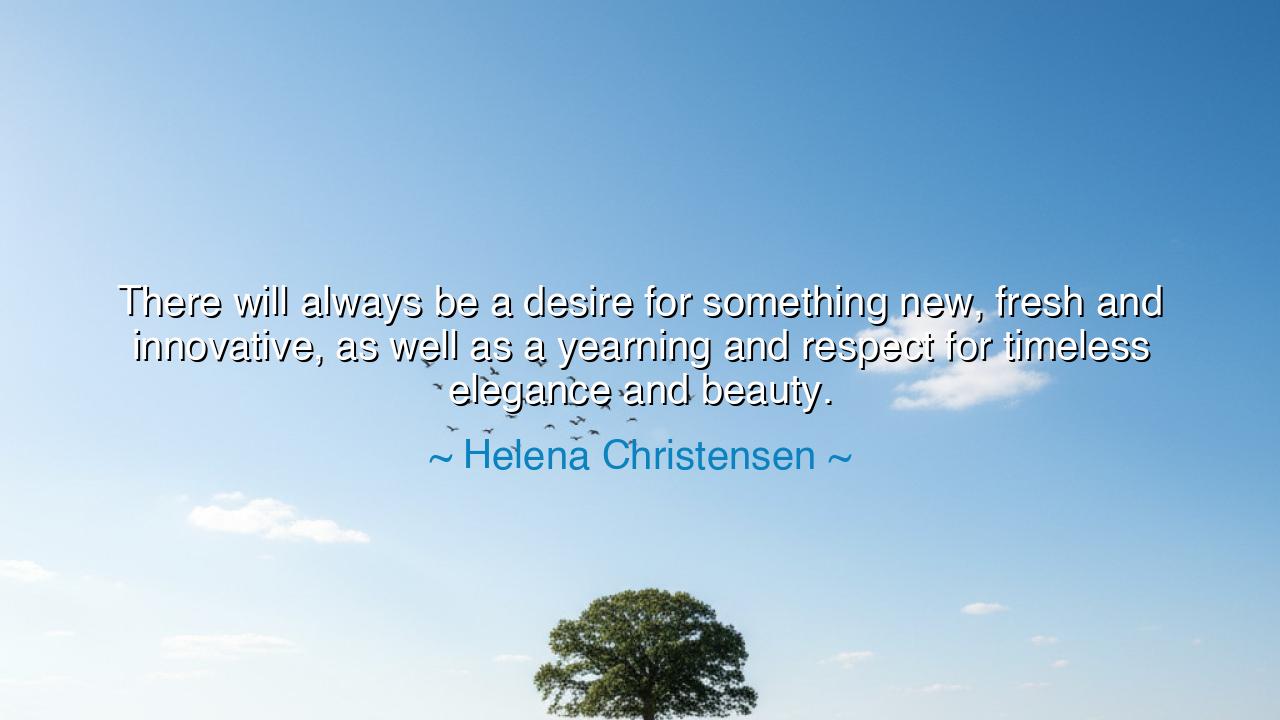
There will always be a desire for something new, fresh and
There will always be a desire for something new, fresh and innovative, as well as a yearning and respect for timeless elegance and beauty.






The words of Helena Christensen—“There will always be a desire for something new, fresh and innovative, as well as a yearning and respect for timeless elegance and beauty”—reveal the eternal dance between change and permanence, between the restless heart that seeks the future and the reverent soul that cherishes the past. Her reflection is not merely about art or fashion, though she herself was shaped by those worlds—it is a meditation on the very nature of humanity. From the dawn of civilization, we have been torn between the thrill of discovery and the comfort of tradition, between invention and reverence, the spark and the stone.
In the ancient temples of Greece, sculptors carved marble into gods and heroes with perfect symmetry, capturing timeless beauty that has endured for millennia. Yet, even as they worked, new artists sought to break the old forms—to make the figures move, to breathe life into stillness. This eternal tension between innovation and preservation has fueled every age of creativity, from the brushstrokes of the Renaissance to the steel and glass of modern architecture. Christensen’s words remind us that the yearning for the new does not erase the old; it completes it. Just as the sunrise does not destroy the stars but reveals them in a different light, so does innovation renew what is eternal.
Consider the tale of Coco Chanel, who rose in an age of extravagant gowns and corsets. She dared to bring forth simplicity and grace—freshness against excess, comfort against restriction. Her designs were new, yet they were born from a profound respect for elegance—for the natural lines of the human form, for the quiet dignity of beauty that does not shout but whispers. Chanel understood, as Christensen does, that the new and the timeless are not enemies; they are reflections of the same pursuit: the search for meaning expressed through form. And that is why her name, though tied to innovation, became synonymous with eternity.
In every generation, there is a longing for rebirth. The young seek to invent a world that is their own, and the old yearn to preserve the grace of what was. Yet the wise know that both desires are sacred. Innovation without reverence becomes arrogance; tradition without renewal becomes decay. Christensen’s insight stands as a compass in this storm of creation. She whispers to the artist, the designer, the thinker, and the dreamer alike: do not choose one over the other. Let your work be both fresh and eternal, daring yet graceful, a bridge between yesterday and tomorrow.
Even nature teaches this truth. The flowers bloom each spring with vibrant color—each blossom unique, fleeting, new. Yet the mountain behind them stands unchanged, ancient, steady, dignified. The wind renews the air; the stone holds the memory of centuries. The universe itself sustains beauty not by destroying what came before, but by layering the new upon the old, like music that builds upon a familiar refrain. This is the rhythm of creation—the same rhythm Christensen evokes in her words.
There is a deeper lesson here, one that goes beyond art and enters the realm of the soul. In every human being lives the dual desire to transform and to belong—to break free and to be rooted. We chase novelty to feel alive, yet we return to simplicity to feel whole. The one without the other leaves us hollow. The ancients adorned their temples with innovations of structure, but they prayed to gods as old as memory. Their wisdom lies in this balance: honor what is timeless, yet never cease to create.
The lesson of Christensen’s words is this: strive to live like the artist of both worlds. Let your mind be open to the winds of innovation, but anchor your heart in values that endure. Seek new ideas, but carry old virtues—grace, humility, beauty, and respect—as your foundation. When you create, do not rush to discard the past; learn from it, reinterpret it, give it breath once more. For the future is not the enemy of the past—it is its child, born anew through the hands of those who remember.
So, my child, when you walk your path—whether through art, work, or life—remember the wisdom of Helena Christensen. Cherish the new, but bow to the timeless. Be bold enough to innovate, but humble enough to revere. In that balance lies not only beauty, but truth. For while fashion may fade and empires may fall, elegance—of form, of heart, of spirit—remains eternal.






AAdministratorAdministrator
Welcome, honored guests. Please leave a comment, we will respond soon